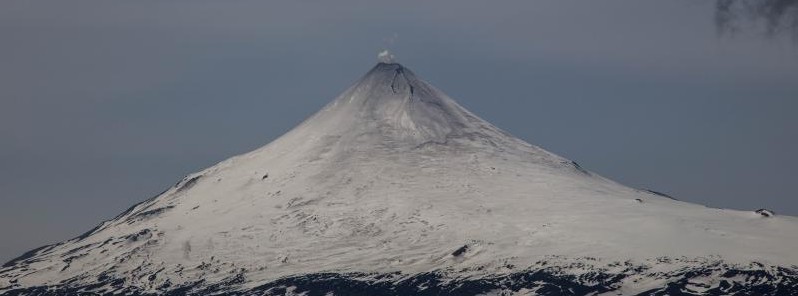Shishaldin volcano alert levels raised, Alaska

Due to increased seismic and infrasound activity recorded over the past few weeks at Shishaldin volcano, the Alaska Volcano Observatory (AVO) raised the Aviation Color Code for the volcano to Yellow and the Alert Level to Advisory on Wednesday, December 6, 2017. The last eruptive episode of this volcano started on January 28, 2014 and ended on October 16, 2015. It had Volcanic Explosivity Index of 1 (on a scale of 1 – 7).
Seismic activity remains elevated and continuous infrasound (air pressure) waves were detected for more than 10 hours on instruments located in Sand Point (~230 km or 140 miles to the east). Satellite and web camera views of the volcano were obscured by clouds Wednesday morning (local time) but vigorous steam emission was observed yesterday afternoon during periods of clear weather.
These observations represent increased unrest at Shishaldin, but do not necessarily indicate that an eruption will occur, AVO said.
Shishaldin is one of the most active volcanoes in the Aleutian volcanic arc, with at least 54 episodes of unrest including over 24 confirmed eruptions since 1775. Most eruptions are relatively small, although the April-May 1999 event generated an ash column that reached 13.7 km (45 000 feet) above sea level.
The last time AVO raised the Aviation Color Code to Yellow and the Alert Level to Advisory was on January 30, 2014. The decision was made based on increased surface temperatures detected at the summit crater, as well as increased steam emission observed on January 29. First small explosions were detected during the second half of March 2014, prompting AVO to raise the Aviation Color Code to Orange and the Alert Level to Watch. They were lowered to Yellow / Advisory on November 20, 2015 and to Green / Normal on March 10, 2016.
Shishaldin is monitored by local seismic and infrasound sensors, satellite data, a web camera, a telemetered geodetic network, and distant infrasound networks.
Geological summary
The beautifully symmetrical volcano of Shishaldin is the highest and one of the most active volcanoes of the Aleutian Islands. The 2857-m-high (9 379 feet), glacier-covered volcano is the westernmost of three large stratovolcanoes along an E-W line in the eastern half of Unimak Island. The Aleuts named the volcano Sisquk, meaning "mountain which points the way when I am lost." A steady steam plume rises from its small summit crater. Constructed atop an older glacially dissected volcano, it is Holocene in age and largely basaltic in composition.
Remnants of an older ancestral volcano are exposed on the west and NE sides at 1500-1800 m elevation. There are over two dozen pyroclastic cones on its NW flank, which is blanketed by massive aa lava flows. Frequent explosive activity, primarily consisting of strombolian ash eruptions from the small summit crater, but sometimes producing lava flows, has been recorded since the 18th century. (GVP)
Featured image: Shishaldin volcano on June 28, 2014. Credit: Dane Ketner, AVO

Commenting rules and guidelines
We value the thoughts and opinions of our readers and welcome healthy discussions on our website. In order to maintain a respectful and positive community, we ask that all commenters follow these rules.